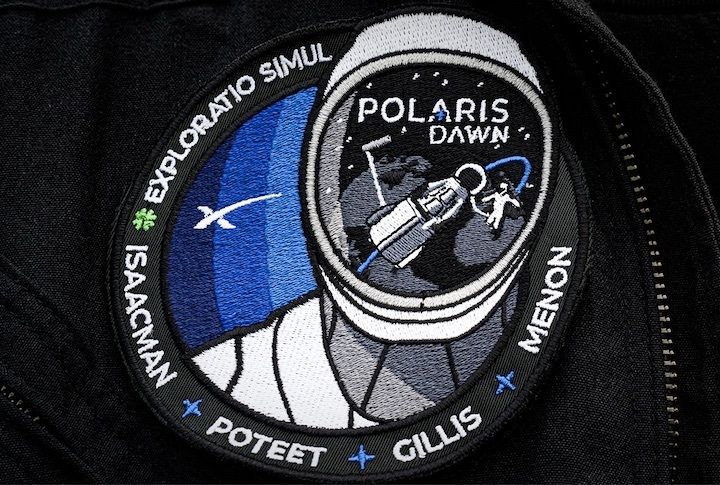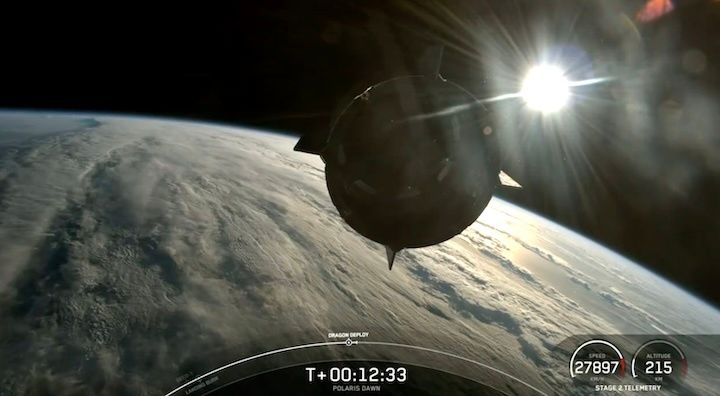12.09.2024

Polaris Dawn crew launches Tuesday with plans for daring spacewalk outside SpaceX Dragon
After rainfall finally cleared from Cape Canaveral, the Polaris Dawn crew roared skyward aboard a SpaceX Falcon 9 amid Tuesday's humid pre-dawn darkness, their rocket's tremendous orange flame slicing through spooky, low-lying layers of hazy clouds resembling fog and smoke.
"Wow!!! The Polaris Dawn crew is now in space!!! This is just the beginning of an incredibly exciting and important mission for the future of human spaceflight, and humanity," SpaceX webcast host Jessie Anderson tweeted after the 5:23 a.m. EDT launch from NASA's Kennedy Space Center.
"These next few days are going to be fascinating," she said.
Anderson helped anchor SpaceX's extended 5½-hour night-owl webcast, which wrapped up shortly after the Polaris Dawn Dragon capsule successfully separated from the Falcon 9's upper stage. The 26½-foot-tall spacecraft previously propelled the Crew-1 and Inspiration4 astronauts into low-Earth orbit.
This time, the Dragon carried Polaris Dawn mission commander and Shift4 founder and billionaire Jared Isaacman; pilot Scott "Kidd" Poteet, a retired U.S. Air Force lieutenant colonel who flew F-16 Fighting Falcons; and two SpaceX lead space operations engineers: mission specialist/medical officer Anna Menon and mission specialist Sarah Gillis.
First, SpaceX expected the Dragon to orbit Earth about eight times before climbing up to 1,400 km, or 870 miles, above the Earth's surface — the highest humans have traveled in Earth’s orbit since the completion of the Apollo program over 50 years ago.
Then, on Day 3 of the five-day mission, a daring spacewalk will expose all four crew members to the vacuum of space while wearing and testing SpaceX's newly designed spacesuits. This will represent the world's first commercial spacewalk.
In a science fiction-esque Tuesday tweet leading up to liftoff, SpaceX officials said the new spacesuits feature "a scalable design with the intent to create millions to help make life multiplanetary."
Weather presented a challenge up to liftoff
Polaris Dawn bucked meteorological odds: The Space Force's 45th Weather Squadron only forecasted 40% odds of favorable weather, citing thick cloud layers, cumulus clouds, flight through precipitation and ascent-corridor recovery weather.
Cloud cover and precipitation did prompt SpaceX to push back its original 3:38 a.m. launch target as rain showers were passing over pad 39A. SpaceX webcast host John Insprucker cited "dynamic conditions" as the key meteorological reason.
"The bigger problem is, there are frontal boundaries north and south of the launch site — and we were then seeing cells popping up. And that made us a little concerned that they may still be around at T-0, and we would then have had to scrub for the day," Insprucker told viewers about 3 a.m.
"So the good news is, we are still counting down for launch. We're going to wait two hours and change, and see how things go," Insprucker said.
After Tuesday's launch, the Falcon 9 first-stage booster landed aboard SpaceX's drone ship Just Read the Instructions hundreds of miles to the northeast in the Atlantic Ocean, completing its fourth mission.
Polaris Dawn marked the 63rd orbital launch of the year thus far from KSC and neighboring Cape Canaveral Space Force Station. The last previous launch was SpaceX's Starlink 8-11 mission, which took flight Thursday morning.
The all-time annual record from Florida's Space Coast is 72 launches, which was just set last year.
Quelle: Florida Today
+++
NASA to Test Telemedicine, Gather Essential Health Data with Polaris Dawn Crew

NASA researchers will soon benefit from a suite of experiments flying aboard a new fully-commercial human spaceflight mission, strengthening future agency science as we venture to the Moon, Mars and beyond.
The experiments are flying as part of the Polaris Dawn mission which launched aboard a SpaceX Dragon spacecraft and Falcon 9 rocket earlier today.
The four-person Polaris Dawn crew of Jared Isaacman, Scott “Kidd” Poteet, Sarah Gillis, and Anna Menon will conduct science during the mission including essential health and human performance research for NASA’s Human Research Program. The research will help NASA scientists better understand how exposure to space conditions affects the human body. The crew will test new medical approaches and technology on telemedicine capabilities, gather data on space motion sickness, and better characterize flight-associated injury risks.
“Each mission, whether the crew is comprised of commercial or NASA astronauts, provides a key opportunity to expand our knowledge about how spaceflight affects human health,” said Jancy McPhee, associate chief scientist for human research at NASA. “Information gathered from Polaris Dawn will give us critical insights to help NASA plan for deeper space travel to the Moon and Mars.”
The crew will test drive, a commercial device that can collect and integrate measurements of health, including blood pressure, heart rate, respiration rate, and temperature. The technology also provides ultrasound imaging and larynx and throat-focused video camera capabilities, and includes an experimental telemedicine feature that could help diagnose crew members in near-real time.
To test this technology during the mission, crew members will compare vital sign collection from the device with data gathered from standard periodic health status exams. The technology’s telemedicine feature, which relies on SpaceX’s Starlink communications system to connect with doctors and specialists on Earth, will also be tested during a simulation. During the test, the device will attempt to offer an appropriate diagnosis based on crew inputs and available documentation.
“Crew members will need to be more self-reliant during lengthy missions, and we hope that telemedicine can provide crews with assistance,” said McPhee.
Another research project aims to better understand and prevent the motion sickness symptoms that many astronauts experience in space. Participating crew members will describe their motion sickness symptoms, what interventions they tried to alleviate their symptoms, and whether any approaches helped.
A separate NASA-based research project will survey crew members after their mission to see whether they experienced any injuries or discomfort during re-entry to Earth.
“Our team will take the crew’s survey data and combine it with information gathered from sensors on the spacecraft. This will allow us to link crews’ reported experiences and health outcomes with the spacecraft’s dynamics and landing loads,” said Preston Greenhalgh, an injury biomechanist at NASA who is leading this work.
Crew members also will participate in a variety of other health studies on behalf of the NASA-funded TRISH (Translational Research Institute for Health), a consortium with various academic institutions. As part of that work, the Polaris Dawn mission will set a new baseline for collecting standard health data on commercial spaceflights, creating a complement to the datasets routinely collected from NASA astronauts and missions.
Polaris Dawn crew members participating in these TRISH studies will provide data about how spaceflight affects mental and physical health through a rigorous set of medical tests and scans completed before, after, and during the mission. The work will include assessments of behavior, sleep, bone density, eye health, cognitive function, and other factors, as well as analysis of blood, urine, and respiration.
“We’re so grateful to the crew members who volunteer to be part of NASA’s work. The insights that we gain from each study may trigger breakthroughs that will help ensure future mission success,” said McPhee.
____
NASA’s Human Research Program pursues the best methods and technologies to support safe, productive human space travel. Through science conducted in laboratories, ground-based analogs, commercial missions, and the International Space Station, the program scrutinizes how spaceflight affects human bodies and behaviors. Such research continues to drive NASA’s mission to innovate ways that keep astronauts healthy and mission-ready as space exploration expands to the Moon, Mars, and beyond.
Quelle: NASA
+++
Polaris Dawn crew flies higher than 1966 Gemini 11 orbital record

A 1966 Gemini XI (11) "Fliteline" medallion (at left) and 2024 Polaris Dawn medallion. Both pieces were flown on their respective record-setting high-apogee missions. (Heritage/Polaris Dawn)
A commercial space crew has flown higher above Earth than anyone who has traveled since the last Apollo astronauts went to the moon.
The four members of the Polaris Dawn mission, riding aboard SpaceX's Dragon spacecraft "Resilience," climbed into an elliptical orbit with a high point, or apogee, of 870 miles (1,400 kilometers) on Tuesday (Sep. 10). They reached the record distance about 15 hours after lifting off at 5:23 a.m. EDT (0923 GMT) from Florida earlier in the day and circling the planet about eight times in an initial orbit of 118 by 746 miles (190 by 1,200 km).
"Achievement unlocked — apogee 1,400.7 km," SpaceX confirmed on its X social media account.
The crew's top altitude more than doubled the maximum height that the space shuttle reached when it deploy the Hubble Space Telescope in 1990 and surpassed the previous record for a crewed spacecraft remaining in Earth orbit of 853 miles (1,373 km) as achieved by NASA's Gemini 11 mission in 1966.
"This is the farthest humans have traveled since the last time humans walked on the moon more than 50 years ago," said Jared Isaacman, the commander and billionaire sponsor of the Polaris Dawn mission, prior to his launch on Tuesday. "Two of my crew members, Sarah [Gillis] and Anna [Menon], will be the women who have traveled farthest from Earth ever, which I think is pretty cool." (The fourth member of the crew is pilot Scott "Kidd" Poteet.)
More than a stunt to make it into the record books, the high flight was achieved in order to collect moredata about how the space environment affected spacecraft systems and the human body. Resilience passed through portions of the Van Allen belt, the zone of energetic charged particles that surround Earth and protects it from most of the Sun's radiation and cosmic rays.
The Polaris Dawn flight is the first of three commercial missions planned by Isaacman to advance research and technology needed to send humans further out into the solar system.
"When you go into this environment, you're dealing with totally different realities than, for example, when you would go to the [International] space station," he said. "it's a lot of energy going into the vehicle. It's a lot of energy to take out of the vehicle when you come back home. It is a different radiation environment. It is a different micrometeorite and orbital debris environment. We stand to learn quite a bit from that in terms of human health, science and research."
"If we get to Mars someday, we'd love to be able to come back and be healthy enough to tell people about it," he said.
The data collected will also help SpaceX refine its future vehicle architecture. Radiation can interfere with spacecraft systems. This is the first time, for example, that touchscreens and other modern digital displays have been exposed to such levels on a mission.
In response to the risks, Resilience was scheduled to spend only about 10 hours at altitude — the minimum amount of time needed to collect the desired data — before lowering into a 118 by 461 mile (190 by 742 km) orbit.
Gemini 11 astronauts Charles "Pete" Conrad and Richard "Dick" Gordon did not live to see their record broken (Conrad died in 1999 and Gordon in 2017). They achieved their altitude by first rendezvousing and docking with an Agena target vehicle and then using its rocket engine to raise their orbit. The Polaris Dawn crew used the Dragon's integrated Draco thrusters to do the same.
Like Conrad and Gordon, Isaacman, Poteet, Gillis and Menon plan to follow-up their record altitude with a spacewalk — in Polaris Dawn's case, the first to be done by a commercial crew — before returning to Earth.
As a nod to the 1966 mission, the Polaris Dawn crew has with them at least one medallion struck with a design similar to the Gemini 11 patch. The modern version replaces the Gemini-Agena vehicle with a Dragon capsule and swaps out the representation of Gordon on one of his extravehicular activities (EVAs) with a spacewalker clad in a SpaceX spacesuit.
